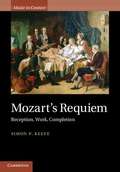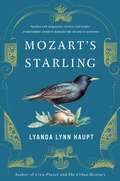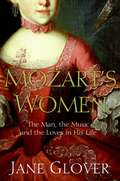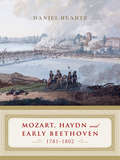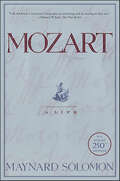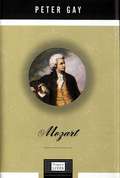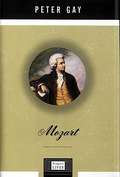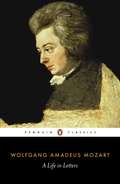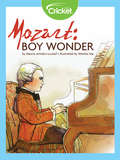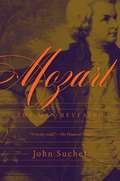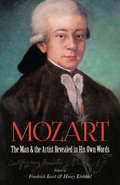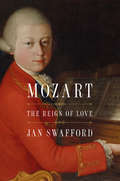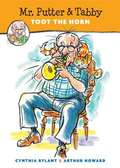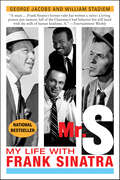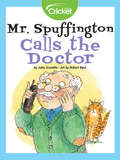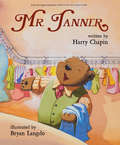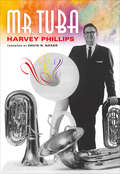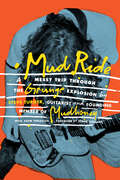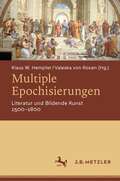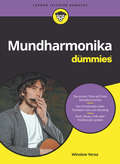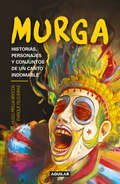- Table View
- List View
Mozart's Requiem: Reception, Work, Completion (Music in Context)
by Simon P. KeefePresenting a fresh interpretation of Mozart's Requiem, Simon P. Keefe redresses a longstanding scholarly imbalance whereby narrow consideration of the text of this famously incomplete work has taken precedence over consideration of context in the widest sense. Keefe details the reception of the Requiem legend in general writings, fiction, theatre and film, as well as discussing criticism, scholarship and performance. Evaluation of Mozart's work on the Requiem turns attention to the autograph score, the document in which myths and musical realities collide. Franz Xaver Süssmayr's completion (1791-2) is also re-appraised and the ideological underpinnings of modern completions assessed. Overall, the book affirms that Mozart's Requiem, fascinating for interacting musical, biographical, circumstantial and psychological reasons, cannot be fully appreciated by studying only Mozart's activities. Broad-ranging hermeneutic approaches to the work, moreover, supersede traditionally limited discursive confines.
Mozart's Starling
by Lyanda Lynn HauptOn May 27th, 1784, Wolfgang Amadeus Mozart met a flirtatious little starling in a Viennese shop who sang an improvised version of the theme from his Piano Concerto no. 17 in G major. Sensing a kindred spirit in the plucky young bird, Mozart bought him and took him home to be a family pet. For three years, the starling lived with Mozart, influencing his work and serving as his companion, distraction, consolation, and muse.Two centuries later, starlings are reviled by even the most compassionate conservationists. A nonnative, invasive species, they invade sensitive habitats, outcompete local birds for nest sites and food, and decimate crops. A seasoned birder and naturalist, Lyanda Lynn Haupt is well versed in the difficult and often strained relationships these birds have with other species and the environment. But after rescuing a baby starling of her own, Haupt found herself enchanted by the same intelligence and playful spirit that had so charmed her favorite composer.In Mozart's Starling, Haupt explores the unlikely and remarkable bond between one of history's most cherished composers and one of earth's most common birds. The intertwined stories of Mozart's beloved pet and Haupt's own starling provide an unexpected window into human-animal friendships, music, the secret world of starlings, and the nature of creative inspiration. A blend of natural history, biography, and memoir, Mozart's Starling is a tour de force that awakens a surprising new awareness of our place in the world.
Mozart's Women: His Family, His Friends, His Music
by Jane Glover[From the dust jacket:] "Throughout his life, Mozart was inspired, fascinated, amused, aroused, hurt, disappointed and betrayed by women--and he was equally complex to them. But, first and last, Mozart loved and respected women. His mother, his sister, his wife, her sisters, and his female patrons, friends, lovers and fellow artists all figure prominently in his life. And his experience, observation and understanding of women reappear, spectacularly, in the characters he created. As one of our finest interpreters of Mozart's work, Jane Glover is perfectly placed to bring these remarkable women--both real and dramatized--vividly to life. We meet Mozart's mother, Maria Anna and his beloved and devoted sister, Nannerl, perhaps as talented as her brilliant brother but, owing to her sex, destined to languish at home while Wolfgang and their father entertained the drawing rooms of Europe. We meet, too, Mozart's "other family"--his in-laws, the Webers: Constanze, his wife, much maligned by history, and her sisters, Aloysia, Sophie and Josefa. Aloysia and Josefa were highly talented singers for whom Mozart wrote some of his most remarkable music. Aloysia was the first woman whom Mozart truly and passionately loved, and her eventual rejection of him nearly broke his heart. Constanze, though a less gifted singer, proved a steadfast and loving wife and--after Mozart's death--his extremely efficient widow, consolidating his reputation and ensuring that his most enduring legacy, his music, never be forgotten. Mozart's Women is their story. But it is also the story of the women in his operas, all of whom were--like his sister, his mother, his wife and his entire female acquaintance--restrained by the conventions and strictures of eighteenth-century society. Yet through his glorious writing, he identified and released the emotions of his characters. Constanze in Die Entführung aus dem servil; Ilia and Elettra in Idomeneo; Susanna and the Countess in le mozze di Figaro; Donnas Anna and Elvira in Don Giovanni; Fiordiligi, Dorabella and Despina in Così fan tutte; Pamina and the Queen of the Night in Die Zauberflöte: are all examined and celebrated. They hold up the mirror to their audiences and offer inestimable insight, together constituting yet further proof of Mozart's true genius and phenomenal understanding of human nature. Rich, evocative and compellingly readable, Mozart's Women illuminates the music and the man--but, above all, the women who inspired him."
Mozart, Haydn and Early Beethoven: 1781-1802
by Daniel HeartzA vivid portrait of Mozart and Haydn's greatest achievements and young Beethoven's works under their influence. Completing the trilogy begun with Haydn, Mozart and the Viennese School, 1740-1780 and continued in Music in European Capitals: The Galant Style, 1720-1780, Daniel Heartz concludes his extensive chronicle of the Classical Era with this much-anticipated third volume. By the early years of the nineteenth century, "Haydn, Mozart and Beethoven" had become a catchphrase--a commonplace expression signifying musical excellence. Indeed, even in his early career, Beethoven was hailed as the only musician worthy to stand beside Haydn and Mozart. In this volume, Heartz winds up the careers of Haydn and Mozart (who during the 1780s produced their most famous and greatest works) and describes Beethoven's first decade in Vienna, during which he began composing by patterning his works on the two masters. The tumult and instability of the French Revolution serves as a vivid historical backdrop for the tale.
Mozart: A Life
by Maynard SolomonThis scholarly 1995 book is more than a biography. It is a psychological portrait of the whole Mozart family, including Leopold, Wolfgang and Marianne. You don't have to be a musician to get into this book. This very readable biography contains a few musical examples but more emphasizes text and facts. It includes a complete list of all of Mozart's works and an analysis of bibliographical resources including how attitudes about Mozart have changed over time. If your view of Mozart was shaped by the Peter Shaffer play and movie, Amadeus,this book may contain quite a few surprises. Was Mozart poisoned? Was he an eternal child?
Mozart: A Life
by Maynard SolomonOn the occasion of Mozart's two hundred and fiftieth birthday, read Maynard Solomon's Mozart: A Life, universally hailed as the Mozart biography of our time.
Mozart: A Life
by Peter GayMozart's short life (only 35 years) were astoundingly productive. This book tells the story of his life, and provides useful information about his major compositions and associations. There are more comprehensive biographies of Mozart, but this one is not a difficult book to read and will provide enough information to augment the experience of listening to his amazing music.
Mozart: A Life (Grandes Figures, Grandes Signatures Ser.)
by Peter GayA biography of the greatest musical mind in Western history Mozart's unshakable hold on the public's consciousness can only be strengthened by historian and biographer Peter Gay's concise and deft look at the genius's life. Mozart traces the development of the man whose life was a whirlwind of achievement, and the composer who pushed every instrument to its limit and every genre of classical music into new realms. .
Mozart: A Life In Letters
by Wolfgang Amadeus MozartA selection of Mozart's letters, translated into English, complete with notes, linking commentary and chronology.
Mozart: Boy Wonder
by Marcia Amidon LustedWolfgang Amadeus Mozart had amazing talent at a very young age, forever changing the idea of what a child prodigy was.
Mozart: Reception, Work, Completion (The\late Eighteenth-century Composers Ser.)
by SimonP. KeefeThis volume of essays on Wolfgang Amadeus Mozart reflects scholarly advances made over the last thirty years. The studies are broad and focused, demonstrating a large number of viewpoints, methodologies and orientations and the material spans a wide range of subject areas, including biography, vocal music, instrumental music and performance. Written by leading researchers from Europe and North America, these previously published articles and book chapters are representative of both the most frequently discussed and debated issues in Mozart studies and the challenging, exciting nature of Mozart scholarship in general. The volume is essential reading for researchers, students and scholars of Mozart's music.
Mozart: The Man Revealed
by John SuchetThe illustrated life-story of the world’s most beloved composer, bringing vividly to life the man himself, his influences, achievements, and the glittering milieu of the Habsburg empire in eighteenth-century Europe. We think we know the story of Wolfgang Amadeus Mozart's life. Austrian-born to a tyrannical father who worked him fiercely; unhappily married to a spendthrift woman; a child-like character ill at ease amid the aristocratic splendor of the Viennese court; a musical genius who died young thus depriving the world of future glories. Yet only that last point is actually true. In this comprehensive biography, John Suchet examines the many myths and misunderstandings surrounding the world's best-loved composer. From his early days as a child prodigy performing for the imperial royal family in Vienna to the last months of his short life, driven to exhaustion by a punitive workload, one thing remained constant: his happy disposition. Through trials and tribulations, grand successes and disheartening setbacks, Suchet shows us the real Mozart—blessed with an abundance of talent yet sometimes struggling to earn a living. His mischievous nature and earthy sense of humor, his ease and confidence in his own incredible abilities; these were traits that never left him. His music has brought comfort to countless generations; his life, though brief, is no less fascinating.
Mozart: The Man and the Artist Revealed in His Own Words
by Friedrich Kerst Henry KrehbielMozart's adult life was an almost unbroken succession of artistic triumphs and personal disappointments. This collection of excerpts from his letters and from other writings offers a unique opportunity for firsthand insights into the great composer's life and personality.In his own words (as compiled by Friedrich Kerst and translated into English by Henry Edward Krehbiel), Mozart communicates his optimisms and anticipations, his recurrent hopes for a post with a fixed income and suitable prestige; his frequent discouragements when these hopes went unfulfilled and pecuniary difficulties ensued; his unhappiness at Salzburg and his maltreatment at the hands of Archbishop Hieronymus; and the circumstances of his love affair with Aloysia Weber and his subsequent marriage to her sister, Constanze. In all, the book contains 255 observations on such subjects as opera, musical pedagogics, love and friendship, religion and morals, composers and performers, the value of hard work, self-respect and honor, travel, and other matters. Extensive annotations provide background for each excerpt.
Mozart: The Reign of Love
by Jan SwaffordFrom the acclaimed composer and biographer Jan Swafford comes the definitive biography of one of the most lauded musical geniuses in history, Wolfgang Amadeus Mozart.At the earliest ages it was apparent that Wolfgang Mozart’s singular imagination was at work in every direction. He hated to be bored and hated to be idle, and through his life he responded to these threats with a repertoire of antidotes mental and physical. Whether in his rabidly obscene mode or not, Mozart was always hilarious. He went at every piece of his life, and perhaps most notably his social life, with tremendous gusto. His circle of friends and patrons was wide, encompassing anyone who appealed to his boundless appetites for music and all things pleasurable and fun.Mozart was known to be an inexplicable force of nature who could rise from a luminous improvisation at the keyboard to a leap over the furniture. He was forever drumming on things, tapping his feet, jabbering away, but who could grasp your hand and look at you with a profound, searching, and melancholy look in his blue eyes. Even in company there was often an air about Mozart of being not quite there. It was as if he lived onstage and off simultaneously, a character in life’s tragicomedy but also outside of it watching, studying, gathering material for the fabric of his art.Like Jan Swafford’s biographies Beethoven and Johannes Brahms, Mozart is the complete exhumation of a genius in his life and ours: a man who would enrich the world with his talent for centuries to come and who would immeasurably shape classical music. As Swafford reveals, it’s nearly impossible to understand classical music’s origins and indeed its evolutions, as well as the Baroque period, without studying the man himself.
Mozart’s Music of Friends
by Klorman, Edward and McCreless, Patrick Edward Klorman Patrick MccrelessIn 1829 Goethe famously described the string quartet as 'a conversation among four intelligent people'. Inspired by this metaphor, Edward Klorman's study draws on a wide variety of documentary and iconographic sources to explore Mozart's chamber works as 'the music of friends'. Illuminating the meanings and historical foundations of comparisons between chamber music and social interplay, Klorman infuses the analysis of sonata form and phrase rhythm with a performer's sensibility. He develops a new analytical method called multiple agency that interprets the various players within an ensemble as participants in stylized social intercourse - characters capable of surprising, seducing, outwitting, and even deceiving one another musically. This book is accompanied by online resources that include original recordings performed by the author and other musicians, as well as video analyses that invite the reader to experience the interplay in time, as if from within the ensemble.
Mr. Putter And Tabby Toot The Horn (Mr. Putter And Tabby)
by Cynthia Rylant Arthur HowardMr. Putter and his fine cat, Tabby, like sharing music with their neighbors Mrs. Teaberry and her good dog, Zeke. But when Mrs. Teaberry decides they should join a band, Mr. Putter isn’t so sure. He doesn’t even play an instrument--in fact, neither does Mrs. Teaberry. But they aren’t going to let that stop them!
Mr. S: My Life with Frank Sinatra
by William Stadiem George Jacobs"Mr. S: My Life with Frank Sinatra, by former valet-aide George Jacobs with an oh-so-able assist by William Stadiem, has at least five quotable and shocking remarks about the famous on every page. The fifteen years Jacobs toiled for Frank produces a classic of its genre -- a gold-star gossip-lover's dream.... "The rest is showbiz history as it was, and only Ava Gardner, Humphrey Bogart, and Betty Bacall are spared. Marilyn Monroe, Judy Garland, Juliet Prowse, Noel Coward, Cole Porter, Mia Farrow, Elvis Presley, Swifty Lazar, Dean Martin, Peggy Lee, Sammy Davis Jr., Marlene Dietrich, Greta Garbo, Jimmy van Heusen, Edie Goetz, Peter Lawford, and all of the Kennedys come in for heaping portions of 'deep dish,' served hot. Sordid, trashy, funny, and so rat-a-tat with its smart inside info and hip instant analysis that some of it seems too good to be true....
Mr. Spuffington Calls the Doctor
by John GranditsIn this funny story, Mr. Spuffington cuts his finger, bumps his head, and falls asleep in the sun with his cat, Pablo. With each injury, he fears the worst and is quick to call Dr. John. Kids will enjoy learning about how the human body responds to injuries and begins to heal itself.
Mr. Tanner
by Harry ChapinMr. Tanner runs a dry cleaning shop in Dayton, Ohio, where he spends his days greeting his customers with his beautiful baritone voice. His friends and neighbors encourage him to sing professionally instead of cleaning clothes. He eventually takes a chance and travels to New York City to be heard by a concert agent and critics, only to find they weren't hearing what he was feeling. The song Mr. Tanner was released in 1973 off Harry Chapin's Short Stories album. The song was inspired by a mediocre review about a baritone singer in The New York Times. A portion of the proceeds from the sale of this book will go to help support WhyHunger, a charity championed by Harry Chapin himself.
Mr. Tuba
by Harvey PhillipsThe autobiography of &“possibly the greatest tuba player of all time&” (New York Times), the man who &“put class in the low brass.&” (Clark Terry, jazz trumpeter) With warmth and humor, tuba virtuoso Harvey Phillips tells the story of his amazing life and career—from his Missouri childhood through his days as a performer with the King Brothers and the Ringling Bros. and Barnum & Bailey circuses, his training at the Juilliard School, a stint with the U.S. Army Field Band, and his freelance days with the New York City Opera and Ballet. A founder of the New York Brass Quintet, Phillips served as vice president of the New England Conservatory of Music and became Distinguished Professor of Music at Indiana University. The creator of an industry of TubaChristmases, Octubafests, and TubaSantas, he crusaded for recognition of the tuba as a serious musical instrument, commissioning more than 200 works. Enhanced by an extensive gallery of photographs, Mr. Tuba conveys Phillips&’s playful zest for life while documenting his important musical legacy. &“Mr. Tuba is not only a memoir, but it is a history of the twentieth century American music world and a resource for all music teachers and music lovers.&” —NBA Journal &“A lively and informative read.&” —Herald-Times &“[Phillips&’s] autobiography is a fitting end to his life&’s works, underlined with the same sense of inspiration and integrity that informed all of his musical activities.&” —Bloom Magazine
Mud Ride: A Messy Trip Through the Grunge Explosion
by Steve Turner Adem TepedelenA down-and-dirty chronicle of the birth and evolution of the Seattle grunge scene—from amateur skate parks and underground hardcore clubs to worldwide phenomenon—as told by one of its founding fathers and lead guitarist of legendary alternative rock band, Mudhoney.In the late 80s and early 90s, Steve Turner and his friends—Seattle skate punks, hardcore kids, and assorted misfits—started forming bands in each other’s basements and accidentally created a unique sound that spread far beyond their once-sleepy city. Mud Ride offers an inside look at the tight-knit grunge scene, the musical influences and experiments that shaped the grunge sound, and the story of Turner's bands, Green River and Mudhoney, which went from underground flophouse shows to selling out stadiums with Nirvana and Pearl Jam. Including stories about the key moments, musicians, and albums from grunge's beginnings to its come-down from the highs of global success and stardom, this is the first account of the musical phenomenon that took over the world from someone who was there for it all. Written by Steve Turner, lead guitarist of Mudhoney, a foundational grunge band that inspired musical icons from Kurt Cobain to Sonic Youth, Mud Ride features a foreword by Pearl Jam's Stone Gossard and never-before-seen photographs and grunge memorabilia throughout. Take a seat and ride through the messy and muddy grunge scene that grew from the basements of the Northwest and went on to circle the globe.MUST HAVE FOR FANS: For cult fans of Mudhoney and all things Seattle grunge, this is the perfect book to add to your collection. Turner helped put Sub Pop Records on the map, a label that launched bands like Soundgarden and more. Mudhoney was also one of the first American grunge bands to tour Europe and the UK, laying the groundwork for the worldwide explosion of grunge. Learn more about the ins and outs of the birth of grunge and immerse yourself in '80s and '90s Seattle.A GREAT GIFT FOR MUSIC LOVERS: For the aspiring musician or anyone wanting to learn more about music history, this is an illuminating look into grunge and Seattle bands that have gone on to become world-famous. AN ESSENTIAL ROCK HISTORY BOOK: An amazing gift for readers of Legs McNeil and Gillian McCain's Please Kill Me, John Doe and Tom DeSavia's Under the Big Black Sun, and Michael Azerrad's Our Band Could Be Your Life. Anyone wanting to learn more about the history of grunge will delight in this great tell-all read.Perfect for:Music lovers, history buffs, and musiciansFans of Pearl Jam, Nirvana, Hole, Green River, and moreAnyone nostalgic for the '80s and '90s pop culture scenePeople obsessed with grunge, rock, musical movements, or Seattle historyReaders of Please Kill Me, Under the Big Black Sun, Our Band Could Be Your Life, Grunge Is Dead, and Everybody Loves Our Town: An Oral History of GrungeGen Z readers who have embraced all things '90s, from the decade's fashion to its music, and have sparked a resurgence in popularity of grunge bands like Nirvana
Multiple Epochisierungen: Literatur und Bildende Kunst 1500–1800
by Klaus W. Hempfer Valeska Von RosenEntgegen einer pauschalen Kritik an den Epochenbegriffen diskutieren die Beiträge des vorliegenden Bandes historische und systematische Bedingungen der Möglichkeit von Epochisierungen. Unterschiedliche sozio-kulturelle Systeme werfen unterschiedliche Fragen auf. Als Literatur- und Kunstwissenschaftler/innen gehen die Beiträgerinnen und Beiträger von Problemkomplexen ihrer jeweiligen Disziplinen aus, rekurrieren für Lösungsansätze aber auch auf das Theorieangebot anderer historischer Disziplinen wie der Geschichtswissenschaft im Allgemeinen oder der Wissenschaftsgeschichte im Besonderen. - Insgesamt ergibt sich, dass die berechtigte Kritik an der spezifischen Faktur spezifischer Epochisierungen weder aus systematischen noch historischen Gründen den generellen Verzicht auf Epochisierungen nahelegt. Solange kein konsistentes Gegenmodell vorliegt, kann es nur darum gehen, Epochentheorie allgemein und Theorien der jeweiligen Einzelepochen im Zusammenhang zu optimieren.
Mundharmonika für Dummies (Für Dummies)
by Winslow YerxaDas Buch konzentriert sich auf die diatonische Mundharmonika mit zehn Tonkanälen. Es bietet einen allgemeinen Überblick über das Instrument und darüber, was man als Spieler mitbringen sollte. Behandelt wird auch, was man beim Kauf einer Mundharmonika beachten muss, wie man richtig sowohl Akkorde als auch einzelne Töne spielt, die Bending-Technik zum "Biegen" der Töne, diverse Spieltechniken und Tipps, sowie das Spielen in einer Band oder einem Duo. Dabei hilft eine Grifftabelle, die für jede Übung anzeigt, wo die Finger hinmüssen. Der Autor erklärt außerdem, wie man seine Mundharmonika reparieren oder sogar im Klang verbessern kann und gibt Empfehlungen zu verschiedenen Mundharmonika-Alben.
Murga: Historias, personajes y conjuntos de un canto indomable
by Hugo Brocos Enrique FilgueirasEl libro que recorre la historia de uno de los fenómenos culturales e identitarios del Uruguay: la murga. Este trabajo presentado de forma organizada, ágil y entretenida logra -con la fuerza de un coro de murga- cantarnos una historia: una historia de personajes, conjuntos y por qué no de un país. ¿Cómo se compone una murga? ¿Qué rol juega cada integrante arriba y abajo del escenario? ¿Qué compone estrictamente un espectáculo murguero? Son algunas de las preguntas que tendrán respuesta en estas páginas. También, a lo largo de este texto, se podrá recorrer la historia y la evolución de la murga desde La Gaditana que se va a principios del Siglo XX hasta la irrupción de la murga joven como fenómeno y la murga en pleno Siglo XXI; las principales figuras que ayudaron a construir la identidad del género como Tito Pastrana, Pepino, Cachela, pasando por Pepe Veneno, Catusa Silva hasta los referentes actuales, para finalmente recorrer la historia de los conjuntos más importantes y que dejaron y dejan huella en el carnaval uruguayo: Don Bochinche y Compañía, Patos Cabreros, Curtidores de Hongos, Araca la Cana, La Soberana, Los Arlequines, La Reina de la Teja, Falta y Resto entre muchas otras. Un libro fundamental para los amantes de la murga y para aquellos que quieran conocer parte de la historia y la identidad de un país.
